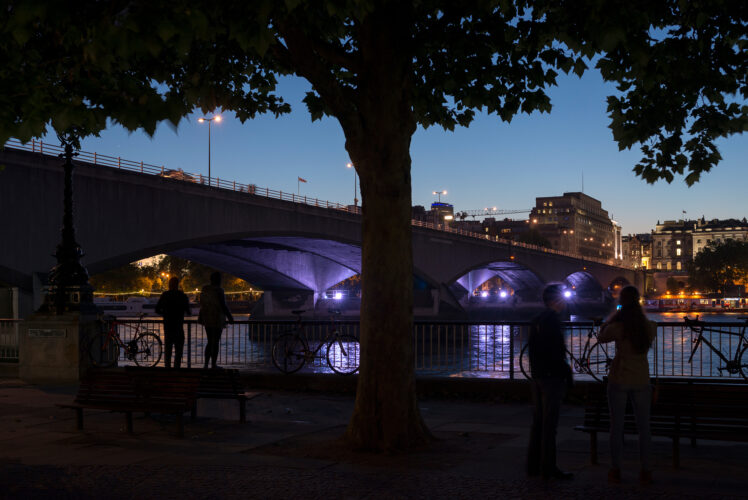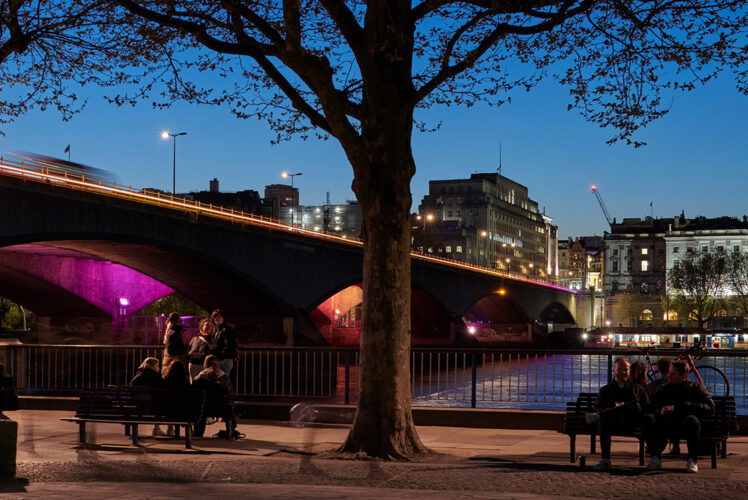Waterloo Bridge
Spring 2021
- Modes
- Owner
- Westminster City Council
- Completed
- 1942 (officially opened 1945)
- Designer
- Sir Giles Gilbert Scott
- Heritage status
- Grade II*
The original bridge, designed by John Rennie the Elder, was opened in 1817 by the Prince Regent accompanied by the Duke of Wellington to commemorate the second anniversary of the Battle of Waterloo.
By the beginning of the 19th century the population of London was already over a million, and both Blackfriars and Westminster bridges were struggling to cope with the resulting increase in traffic. A parliamentary act of 1809 gave the Strand Bridge Company, the largest and most successful of all the toll-bridge builders, the authority to raise £500,000 (in £100 shares) to fund a new bridge. The construction of the bridge drew large crowds and Tsar Alexander I of Russia even visited the site on his 1814 trip to London. The completed structure was supported by nine elliptical arches of Cornish granite, with two Grecian Doric columns on each pier.
The bridge nonetheless fell into disrepair by the mid-1880s, the foundations damaged by the increased tidal scour caused by the removal of the old London Bridge. The piers of Waterloo Bridge were reinforced between 1882 and 1884 and attempts were made up to 1923 to save the ailing bridge, but it was ultimately closed in 1924.
Despite conservationists calling for its repair, London County Council commissioned Sir Giles Gilbert Scott, celebrated today for Battersea Power Station and the red telephone box, to design a new bridge.
During the Second World War, women were employed to complete the construction by the building contractor Peter Lind & Company, hence Waterloo Bridge is known colloquially as the ‘Ladies Bridge’. It was the only bridge in London to suffer multiple hits by German bombers, but it was finally finished in 1945 and opened by Rt. Hon Herbert Morrison on 10 December. At the opening, a race was declared to see who could be the first to cross the bridge. The race was won by Leonard Mitchell, a sixteen-year-old schoolboy from Balham.
At 1,230 feet long and 80 feet wide it is the longest bridge in London and was the first to incorporate electric lights. It is made of reinforced concrete with Portland stone cladding and supporting arched beams on the outside edges. Conveniently, Portland stone is able to ‘clean itself’ whenever it rains which is why the bridge looks as though it is in such impressively good condition. Two of John Rennie’s Doric columns from the original Waterloo Bridge are retained in the southern abutment.
In 1868, a spectacular Iron Age helmet dating from 150-50 BC was recovered from the Thames riverbed at this point. It is the only Iron Age horned helmet to be found in all of Europe. Nicknamed the ‘Waterloo Bridge Helmet’ it can be seen today in the British Museum.

Artist’s Vision
Among the many artists who have found inspiration in Waterloo Bridge, Claude Monet visited London at the turn of the twentieth century to create a series of canvases depicting the bridge’s earlier iteration and nearby vistas. In the spirit of the Impressionists and the English Romantics who captured the Thames and its bridges in their paintings, Leo Villareal’s artwork for Waterloo Bridge incorporates colours that shift and blend, adjusting to the constantly changing riverscape and its surroundings.
Villareal’s references for Waterloo are drawn from the bridge’s architecture, detailing, and history. Citing a visual tie with Millennium Bridge, the artist finds a similar opportunity to explore a single line of light, which, in this instance, introduces colour on the bridge’s masonry arches. Villareal’s artwork complements this existing aesthetic, introducing a 379 meter stretch of lighting across each side of the bridge in addition to washes of light on its underside.

Former lighting on Waterloo Bridge.

Leo Villareal's Illuminated River artwork on Waterloo Bridge.
Image: James Newton





